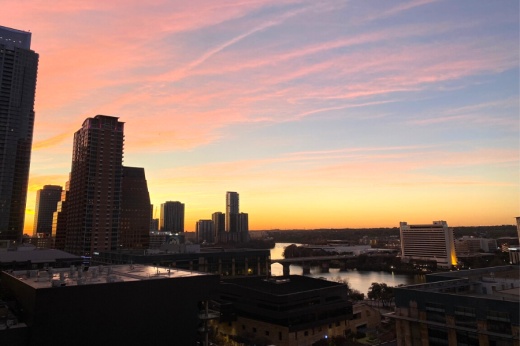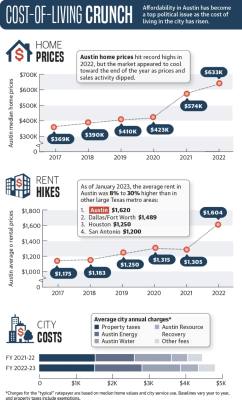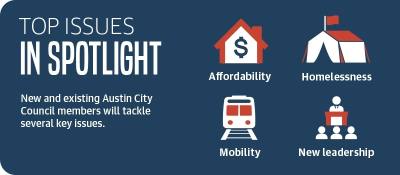After fall elections, four fresh faces now fill seats on Austin’s City Council dais previously held by members with a combined 35 years of City Hall experience. Several new officials ran on the issue of affordability in last fall's election campaigns. They and their returning colleagues are now getting to work on attending to a rising count of people experiencing homelessness and multiple transportation projects picking up steam in 2023.
Those and the cost-of-living question are at the top of an agenda that could see council working quickly to produce tangible results, according to city officials.
“The people [who] that were elected were elected because people want to see action on affordability,” new District 3 Council Member José Velásquez said.
Making ends meet
Mayor Kirk Watson, who served in the role from 1997-2001, and new council representatives all led on messages tied to affordability. Watson, who also campaigned on getting government back to basics, called it the “ultimate basic” for officials to address.
While Austin’s council cannot directly control housing costs, they can influence affordability in other areas. Several officials said they will plan for a narrower city budget and tax rate this summer to limit property taxes amid rising city charges and utility fee hikes.
“I want to start off where it’s a no-new-revenue rate so that what will happen is we may want to put stuff in there that changes that, but you have to justify it,” Watson said.
After a decadelong attempt to rewrite Austin’s land development code stalled in court, officials passed updates designed to spur construction in targeted areas in late 2022. But members said more must be done.
"Since [the land code rewrite] has failed twice already, we should prioritize progress where it's possible and focus on policies that update specific parts of our land code,” said District 2 Council Member Vanessa Fuentes, a proponent of seeing council focus on housing and child care affordability as well as support for working-class families.
While also pro-housing, Velásquez also supports additional ways to relieves Austinites’ wallets, such as free full-day pre-K.
Watson said he believes Austin must add more housing immediately, and he hopes to start off the year by passing items of agreement on the dais after what he deemed an unsuccessful “all-or-nothing approach” in recent years.
Zo Qadri, downtown Austin’s new council member for District 9, said he would like to look at expanding existing city affordability programs while taking another run at wider-reaching policy changes.
“Austin is in a housing crisis, and I think the broadest way to put it is that we need more housing,” he said.
South Austin’s District 5 representative Ryan Alter has his own housing plan, Opportunity Unlocked. He said it could incentivize more affordable housing both in heavily trafficked areas and in neighborhoods.
“The corridors can be a great place to live, ... but if [people] want to live in a neighborhood, that should be an opportunity for them,” Alter said.
A top Watson proposal would require that every council district meet a baseline for new development, inspired by the city’s Strategic Housing Blueprint outlining affordable housing needs citywide. That plan would also financially reward districts adding the most housing.
“Every district has to meet a baseline, but you avoid a comprehensive across-the-city change that creates a veto power,” Watson said.
Austin is also buying up land and supporting new projects with the last of its 2018 housing bond funds and the start of $350 million more approved by voters in November. The city housing department said it expects to fund 750 affordable units in fiscal year 2022-23.
The Austin Development Services Department said its focus is streamlining permitting, a priority shared across the dais as developers have said permitting times are a barrier to building housing quicker.
Unhoused response
Council also faces the task of responding to a growing homeless population: more than 4,600 people were believed to be homeless in the Austin area as of October, according to the Ending Community Homelessness Coalition.
Officials’ work to address homelessness comes as the $515 million Finding Home ATX public-private fundraising initiative continues to play out. The program aims to house at least 3,000 people over three years.
Leaders said the most visible results of the effort, backed by more than $200 million from Austin, will come in 2023 and 2024. The city expects 450 housing units for people exiting homelessness to open this year.
“The Homeless Strategy Division will continue operations to strengthen its collaborative leadership of the communitywide homelessness response system through strategic oversight, continuous improvement, addressing equity, and introducing proven housing and social service interventions,” an HSD spokesperson said.
At City Hall, council members shared mixed reviews of Austin’s work with homelessness. Watson said an increase in transparency and the scope of options for assisting those on the streets is needed, and other members said the city should look to speed up or adjust its path.
“I believe there is room for improvement and a need for better organization and execution in addressing encampments in city parks and on preserved land,” Mayor Pro Tem Paige Ellis said.
Movement on mobility
Council will also be responsible for some management of the Project Connect transit system. While new members generally support the program, its estimated cost—funded by years of a voter-approved tax increase—rose from $7.1 billion to $10 billion last year.
“Project Connect is a mess, and we need the sense of urgency about how we’re going to proceed,” Watson said.
Transportation planners have said a recalibration of the program inspired by its growing price tag will be detailed this spring.
The project is closely linked with the affordability question as rail lines and improved bus routes will likely be a draw for new housing additions. Austin is also allocating millions of dollars for anti-displacement efforts across the system.
The Texas Department of Transportation’s expansion of I-35, another multibillion-dollar project progressing this year, has received more mixed reviews from City Hall.
While Austin’s influence on that work is limited, council could promote changes such as caps and stitches bridging East and West Austin across the highway—designs that could cost the city hundreds of millions. Some members, including District 10 Council Member Alison Alter, support the the project with added caps and stitches.
That full slate of activity plus an infusion of energy from new members could preview a more active City Hall in the year to come, said Steven W. Pedigo, director of The University of Texas at Austin’s LBJ Urban Lab.
“I wonder if we see this body kind of embrace that narrative of wanting to ‘prove’ to the general public and the [electorate] that they can be effective ... and actually moving policy forward for the city,” he said.








